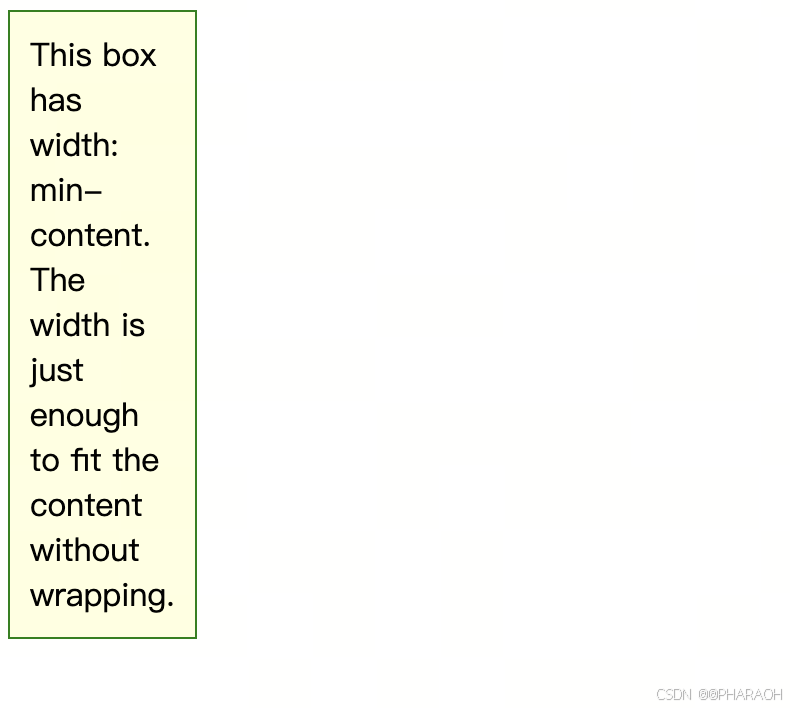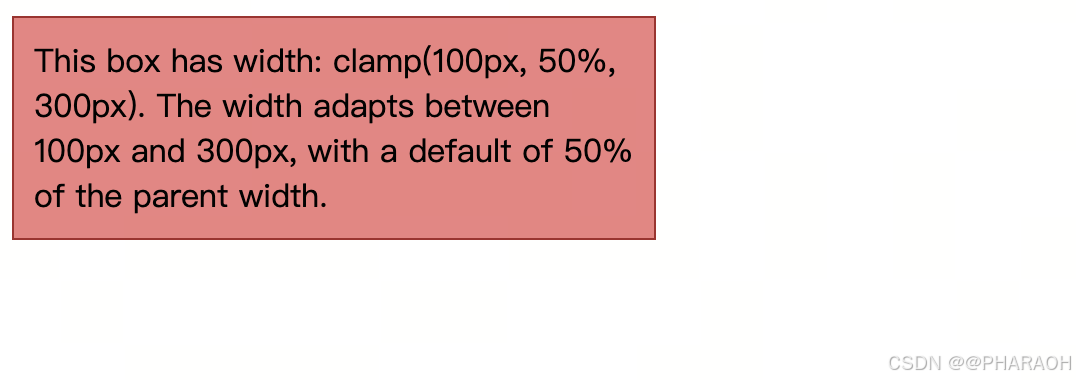目录
一、前言
width 可以说是在前端开发布局中最重要的一个布局属性。
官方文档:https://developer.mozilla.org/en-US/docs/Web/CSS/width
二、介绍
在 CSS 中,width 属性用于设置元素的宽度。它可以接受多种取值,分别适用于不同的布局需求和场景。
下面是常见的 width 属性取值及其区别:
1. 固定宽度(具体单位)
px(像素): 最常用的固定单位,指定元素的宽度为固定的像素值。.box { width: 200px; /* 宽度固定为 200 像素 */ }em: 相对单位,基于元素的字体大小来计算宽度。.box { width: 20em; /* 宽度为 20 倍的字体大小 */ }rem: 相对单位,基于根元素的字体大小来计算宽度。.box { width: 15rem; /* 宽度为 15 倍的根元素字体大小 */ }%(百分比): 相对单位,基于包含块的宽度来计算元素的宽度。.box { width: 50%; /* 宽度为包含块宽度的 50% */ }
2. 相对单位
vw(视口宽度): 相对单位,基于视口宽度的百分比。1vw 等于视口宽度的 1%。.box { width: 50vw; /* 宽度为视口宽度的 50% */ }vh(视口高度): 相对单位,基于视口高度的百分比。1vh 等于视口高度的 1%。.box { width: 50vh; /* 宽度为视口高度的 50% */ }
3. 自适应宽度
auto: 默认值,宽度自动调整以适应其内容或根据其他布局规则。.box { width: auto; /* 宽度自动调整 */ }min-content: 设置宽度为内容的最小宽度,防止内容溢出。.box { width: min-content; /* 宽度为内容的最小宽度 */ }max-content: 设置宽度为内容的最大宽度,内容不会被换行或截断。.box { width: max-content; /* 宽度为内容的最大宽度 */ }fit-content: 让宽度根据内容的大小来调整,最大值由额外的值指定(如果有的话)。.box { width: fit-content; /* 宽度根据内容的大小自动调整 */ }
4. 其他布局特性
calc(): 允许你使用数学计算来设置宽度。.box { width: calc(100% - 20px); /* 宽度为 100% 减去 20 像素 */ }clamp(): 设置宽度在一个最小值和最大值之间,根据内容和屏幕尺寸进行调整。.box { width: clamp(100px, 50%, 300px); /* 宽度在 100px 到 300px 之间,通常取 50% */ }
总结
- 固定宽度: 使用
px,em,rem设置固定宽度。 - 相对单位: 使用
%,vw,vh根据包含块或视口尺寸设置宽度。 - 自适应宽度: 使用
auto,min-content,max-content,fit-content根据内容或布局调整宽度。 - 计算和范围: 使用
calc(),clamp()实现更复杂的宽度计算。
不同的 width 属性取值适用于不同的场景和需求,选择合适的值可以帮助你实现所需的布局效果。
三、自适应宽度(重点)
在 CSS 中,自适应宽度可以通过多种方式实现,以适应不同的布局需求。以下是对几种常见的自适应宽度取值的详细比较:
1. auto
定义: 默认值,元素的宽度自动调整以适应其内容,或者根据其他布局规则进行调整。
适用场景: 适用于需要元素根据其内容或上下文自动调整宽度的情况。
特点:
- 灵活性: 宽度会根据内容或父元素的约束自动调整。
- 默认行为: 常用于块级元素,通常不需要额外的宽度设置。
.box { width: auto; /* 宽度自动调整 */ }示例: 一个
<div>包含动态内容,width: auto允许它的宽度根据内容自适应。代码示例
<!DOCTYPE html>
<html lang="en">
<head>
<meta charset="UTF-8">
<meta name="viewport" content="width=device-width, initial-scale=1.0">
<title>Width: auto</title>
<style>
.container {
border: 2px solid black;
padding: 10px;
width: 50%;
}
.box {
width: auto;
border: 1px solid blue;
padding: 10px;
}
</style>
</head>
<body>
<div class="container">
<div class="box">This box has width: auto. It will adjust to fit its content.</div>
</div>
</body>
</html>

box 宽度为父元素的宽度。
2. min-content
定义: 设置宽度为内容的最小宽度,即内容不会被换行或裁剪。
适用场景: 当你希望元素的宽度足够容纳其内容的最小尺寸,但不希望超出内容的最小宽度。
特点:
- 内容驱动: 元素宽度是内容的最小宽度,不会小于内容所需的最小宽度。
- 避免溢出: 避免内容被裁剪或换行,适用于确保内容完全显示的情况。
.box { width: min-content; /* 宽度为内容的最小宽度 */ }示例: 一个表单控件,其宽度不小于其内容的宽度,以确保没有内容被隐藏。
代码示例
<!DOCTYPE html>
<html lang="en">
<head>
<meta charset="UTF-8">
<meta name="viewport" content="width=device-width, initial-scale=1.0">
<title>Width: min-content</title>
<style>
.box {
width: min-content;
border: 1px solid green;
padding: 10px;
background-color: lightyellow;
}
</style>
</head>
<body>
<div class="box">This box has width: min-content. The width is just enough to fit the content without wrapping.</div>
</body>
</html>

3. max-content
定义: 设置宽度为内容的最大宽度,即元素的宽度会根据内容的最大尺寸来确定。
适用场景: 当你希望元素的宽度足够容纳其内容的最大尺寸,但不希望超过内容的最大宽度。
特点:
- 内容驱动: 元素宽度是内容的最大宽度,不会超过内容的最大宽度。
- 避免换行: 确保内容不会被换行或裁剪,适用于需要显示完整内容的情况。
.box { width: max-content; /* 宽度为内容的最大宽度 */ }示例: 一个按钮,其宽度根据按钮内容的最长文本来确定,以确保文本不被截断。
代码示例
<!DOCTYPE html>
<html lang="en">
<head>
<meta charset="UTF-8">
<meta name="viewport" content="width=device-width, initial-scale=1.0">
<title>Width: max-content</title>
<style>
.box {
width: max-content;
border: 1px solid red;
padding: 10px;
background-color: lightpink;
}
</style>
</head>
<body>
<div class="box">This box has width: max-content. The width is as wide as the longest content without wrapping.</div>
</body>
</html>

可以发现,当内容超出时,会形成滚动,而不是换行。
4. fit-content
定义: 设置宽度为内容的大小,最大值由额外的值指定。如果内容宽度超过这个值,则会限制宽度到最大值。
适用场景: 当你希望元素宽度根据内容自动调整,但需要设定最大宽度限制。
特点:
- 内容和限制: 元素宽度根据内容自动调整,但可以指定最大宽度。
- 灵活性: 适用于需要根据内容调整宽度但有最大宽度限制的情况。
.box { width: fit-content; /* 宽度根据内容自动调整 */ }示例: 一个弹出框,其宽度根据内容自动调整,但有一个最大宽度,以防内容过多导致弹出框过宽。
代码示例
<!DOCTYPE html>
<html lang="en">
<head>
<meta charset="UTF-8">
<meta name="viewport" content="width=device-width, initial-scale=1.0">
<title>Width: fit-content</title>
<style>
.box {
width: fit-content;
max-width: 300px; /* Optional: limit the maximum width */
border: 1px solid purple;
padding: 10px;
background-color: lightblue;
}
</style>
</head>
<body>
<div class="box">This box has width: fit-content. The width adjusts to fit the content but won't exceed the maximum width of 300px.</div>
</body>
</html>

5. calc()
定义: 允许你使用数学计算来设置宽度。例如,可以计算相对于父元素宽度的百分比和固定值的组合。
适用场景: 当你需要动态计算宽度,并结合固定值和相对值时。
特点:
- 灵活性: 支持复杂的计算,可以结合不同单位进行设置。
- 动态调整: 适用于需要根据不同条件动态调整宽度的情况。
.box { width: calc(100% - 20px); /* 宽度为父元素宽度减去 20 像素 */ }示例: 一个侧边栏,其宽度为父容器宽度减去固定的边距,以实现自适应布局。
代码示例
<!DOCTYPE html>
<html lang="en">
<head>
<meta charset="UTF-8">
<meta name="viewport" content="width=device-width, initial-scale=1.0">
<title>Width: calc()</title>
<style>
.box {
width: calc(100% - 40px); /* Width is 100% of the parent minus 40 pixels */
border: 1px solid orange;
padding: 10px;
background-color: lightgreen;
}
</style>
</head>
<body>
<div style="width: 100%; border: 2px solid black;">
<div class="box">This box has width: calc(100% - 40px). The width is calculated based on the parent element's width minus 40px.</div>
</div>
</body>
</html>

6. clamp()
- 语法
clamp(MIN, VAL, MAX)
MIN: 设定值的最小值。如果计算的值小于这个最小值,那么使用这个最小值。
VAL: 推荐值或理想值,浏览器会尽量使用这个值,但会根据最小值和最大值进行调整。
MAX: 设定值的最大值。如果计算的值大于这个最大值,那么使用这个最大值。
定义: 设置宽度在最小值和最大值之间,并根据内容的大小进行调整。
适用场景: 当你希望宽度在一定范围内自适应,并且有最小和最大限制。
特点:
- 范围限制: 允许宽度在指定的范围内自适应,避免过小或过大的宽度。
- 动态调整: 根据内容大小调整宽度,但有上限和下限。
.box { width: clamp(100px, 50%, 300px); /* 宽度在 100px 到 300px 之间,根据 50% 调整 */ }
最小值 (100px): 盒子宽度不会小于 100px。
推荐值 (50%): 盒子宽度优先取 50% 的父元素宽度。
最大值 (300px): 盒子宽度不会大于 300px。
示例: 一个响应式布局的容器,其宽度在最小和最大值之间自适应,以适应不同屏幕尺寸。
代码示例
<!DOCTYPE html>
<html lang="en">
<head>
<meta charset="UTF-8">
<meta name="viewport" content="width=device-width, initial-scale=1.0">
<title>Width: clamp()</title>
<style>
.box {
width: clamp(100px, 50%, 300px); /* Width is between 100px and 300px, usually 50% of the parent */
border: 1px solid brown;
padding: 10px;
background-color: lightcoral;
}
</style>
</head>
<body>
<div class="box">This box has width: clamp(100px, 50%, 300px). The width adapts between 100px and 300px, with a default of 50% of the parent width.</div>
</body>
</html>

总结
auto: 默认值,宽度自动调整以适应内容或布局规则。min-content: 宽度为内容的最小宽度,避免内容被裁剪。max-content: 宽度为内容的最大宽度,确保内容完整显示。fit-content: 宽度根据内容调整,最多到指定的最大值。calc(): 支持数学计算,可以结合不同单位设置宽度。clamp(): 在指定的最小和最大值之间自适应,适用于响应式设计。
选择适当的 width 取值可以根据布局需求和内容特点来确保设计的灵活性和可用性。
四、拓展:clamp()
clamp() 是一个 CSS 函数,用于设置一个属性值,使其在一个范围内自适应。这个函数非常有用,尤其是在响应式设计中,它允许你定义一个值的范围,确保它在最小和最大值之间变化。
clamp() 语法
clamp(MIN, VAL, MAX)
MIN: 设定值的最小值。如果计算的值小于这个最小值,那么使用这个最小值。VAL: 推荐值或理想值,浏览器会尽量使用这个值,但会根据最小值和最大值进行调整。MAX: 设定值的最大值。如果计算的值大于这个最大值,那么使用这个最大值。
使用示例
下面是几个具体的例子,展示了如何使用 clamp() 函数来设置宽度:
1. 文本宽度自适应
<!DOCTYPE html>
<html lang="en">
<head>
<meta charset="UTF-8">
<meta name="viewport" content="width=device-width, initial-scale=1.0">
<title>Width: clamp()</title>
<style>
.box {
width: clamp(200px, 50%, 600px);
border: 1px solid blue;
padding: 10px;
box-sizing: border-box;
background-color: lightyellow;
}
</style>
</head>
<body>
<div class="box">
This box's width is set using clamp(). It will be at least 200px, up to a maximum of 600px, and ideally 50% of the parent width.
</div>
</body>
</html>
解释:
- 最小值 (
200px): 盒子宽度不会小于 200px。 - 推荐值 (
50%): 盒子宽度优先取 50% 的父元素宽度。 - 最大值 (
600px): 盒子宽度不会大于 600px。
这个设置确保了 .box 元素在任何屏幕尺寸下都能适应,既不会太小也不会太大。
2. 响应式字体大小
<!DOCTYPE html>
<html lang="en">
<head>
<meta charset="UTF-8">
<meta name="viewport" content="width=device-width, initial-scale=1.0">
<title>Font Size: clamp()</title>
<style>
.text {
font-size: clamp(1rem, 2vw, 2.5rem);
background-color: lightgreen;
padding: 20px;
border: 1px solid green;
}
</style>
</head>
<body>
<div class="text">
This text size is set using clamp(). It will be at least 1rem, up to a maximum of 2.5rem, and ideally 2vw of the viewport width.
</div>
</body>
</html>
解释:
- 最小值 (
1rem): 字体大小不会小于 1rem。 - 推荐值 (
2vw): 字体大小优先取视口宽度的 2%。 - 最大值 (
2.5rem): 字体大小不会大于 2.5rem。
如何工作
clamp() 函数根据当前环境计算推荐值(VAL),然后确保计算出的值在指定的最小值(MIN)和最大值(MAX)之间。例如:
- 在小屏幕上,
2vw可能会小于1rem,因此使用1rem。 - 在大屏幕上,
2vw可能会大于2.5rem,因此使用2.5rem。 - 在中等屏幕上,
2vw可能正好在1rem和2.5rem之间,最终使用2vw。
总结
clamp() 函数提供了一种简单的方法来创建灵活的设计。它结合了最小值、推荐值和最大值,确保元素在不同的环境下表现得既合理又美观。